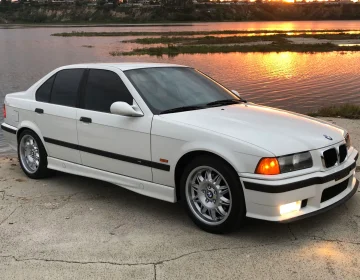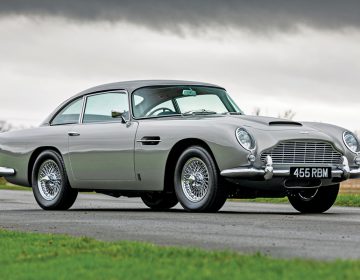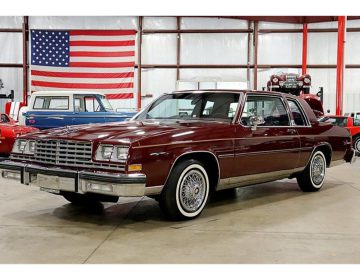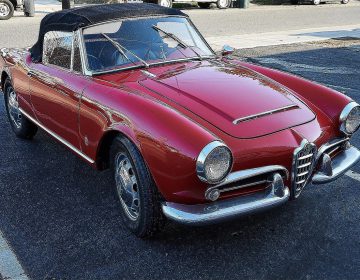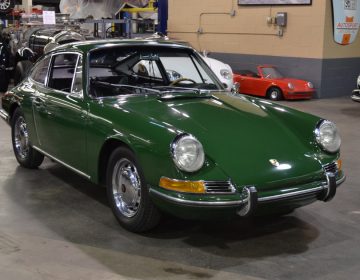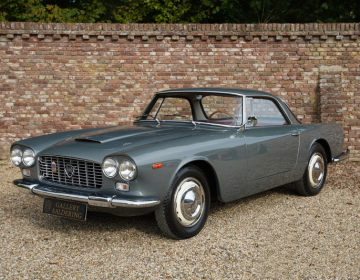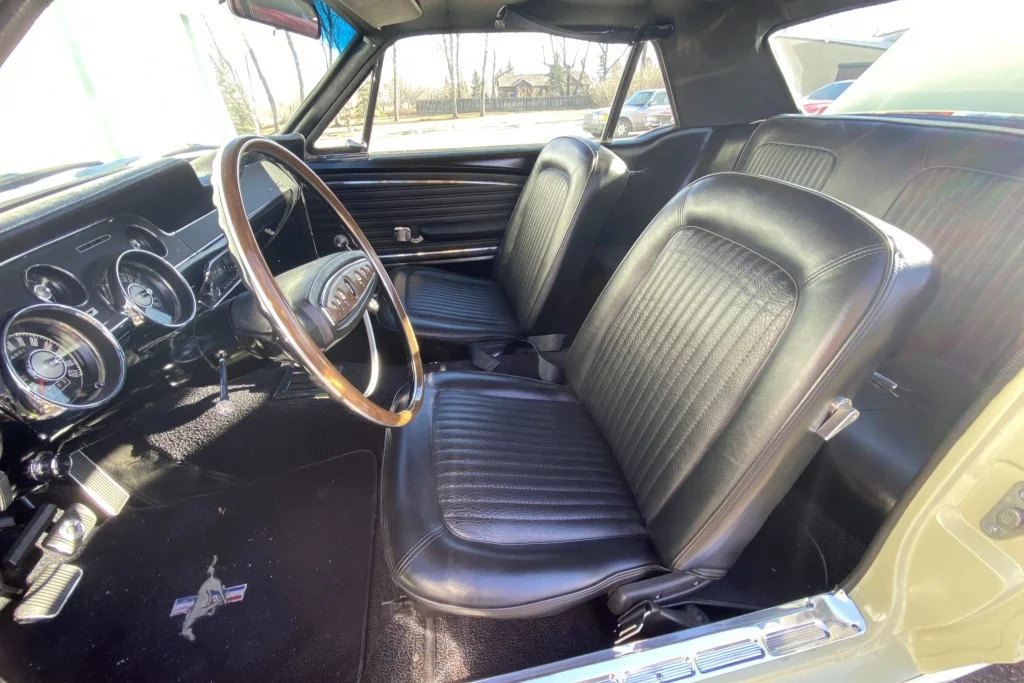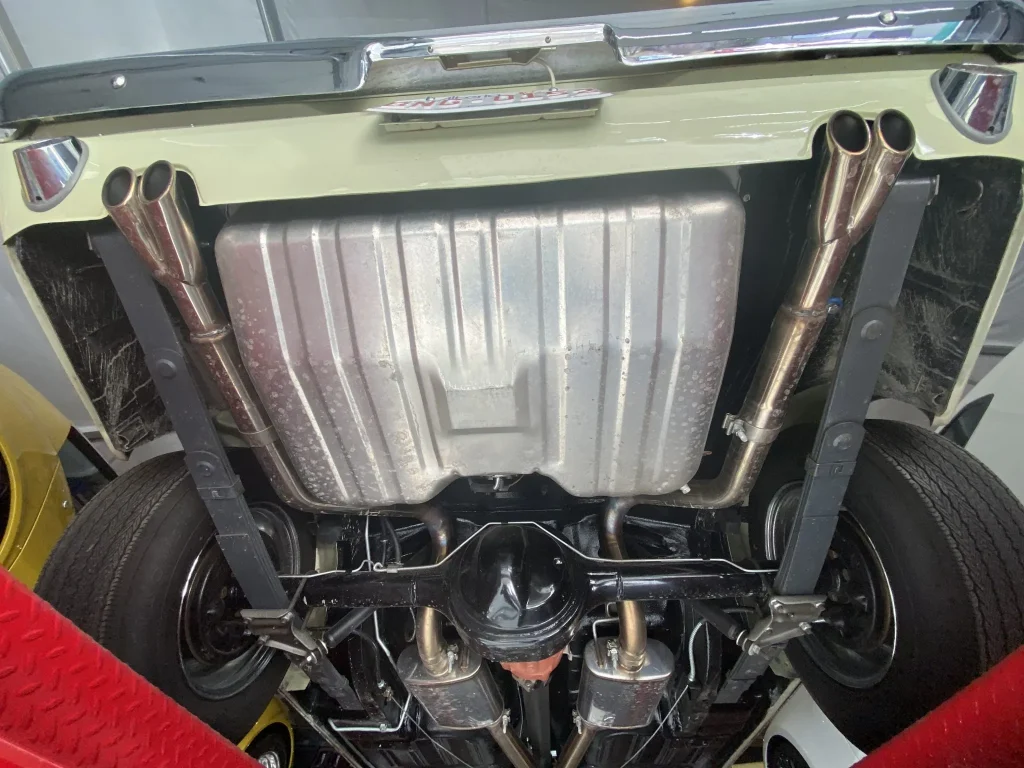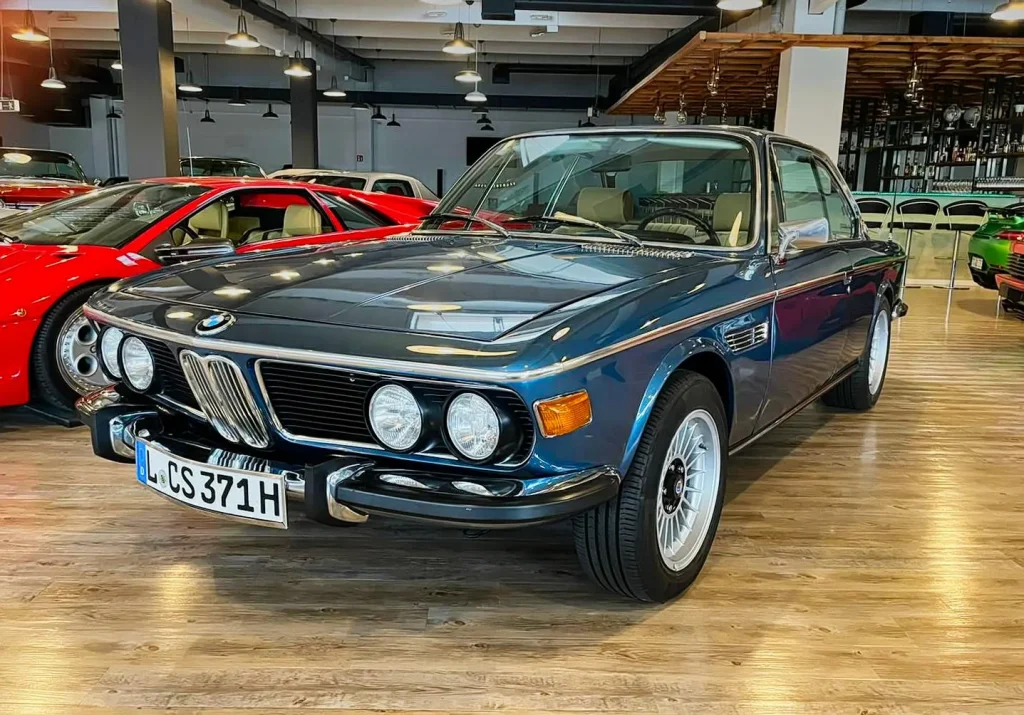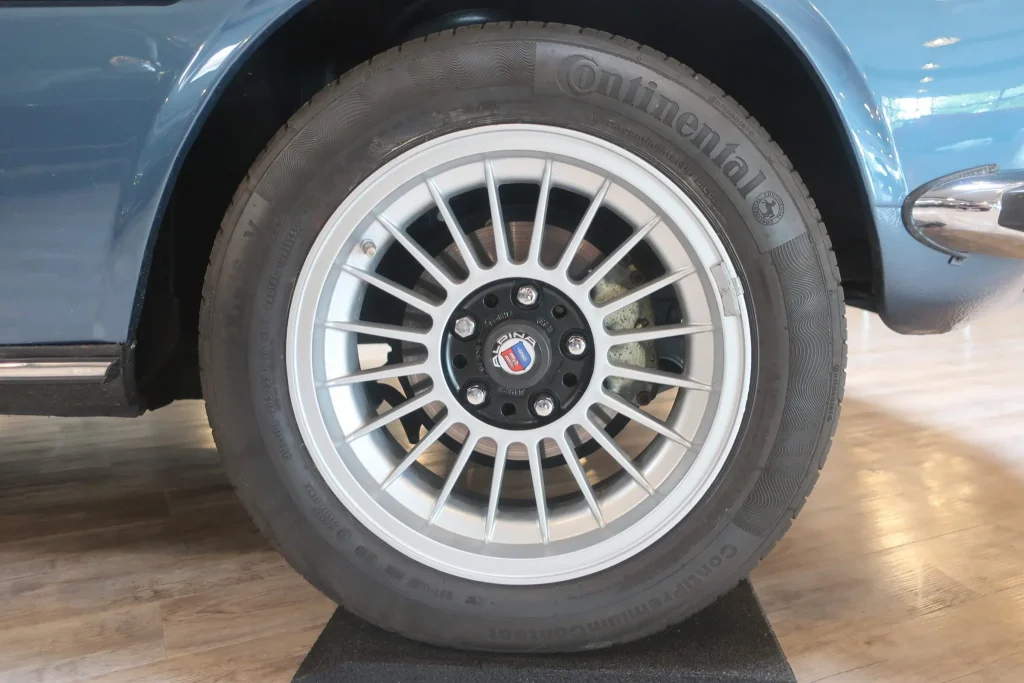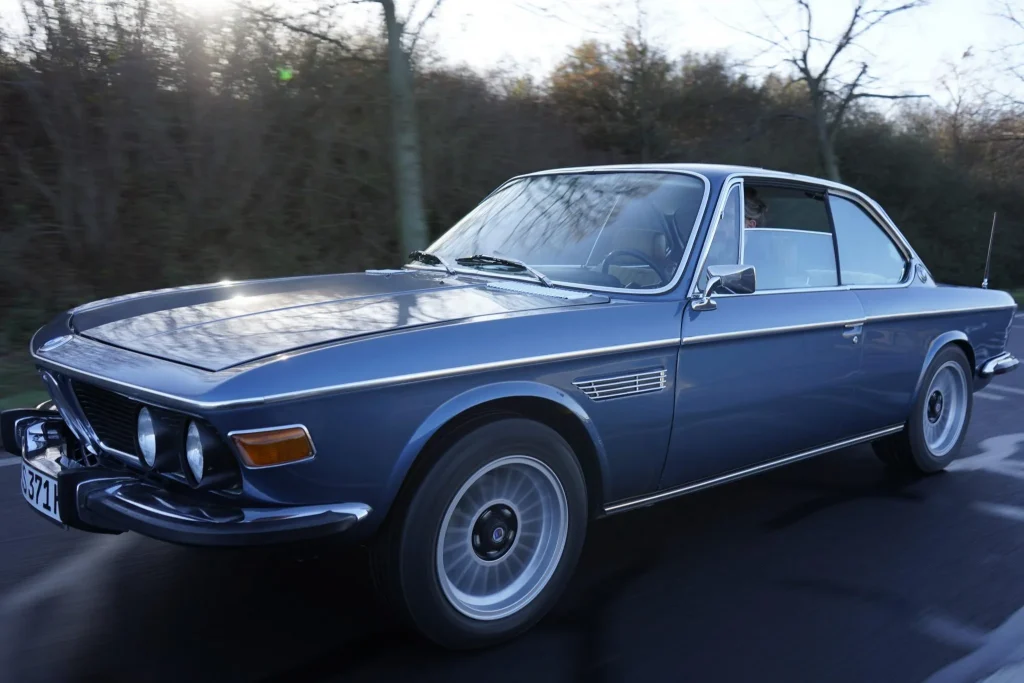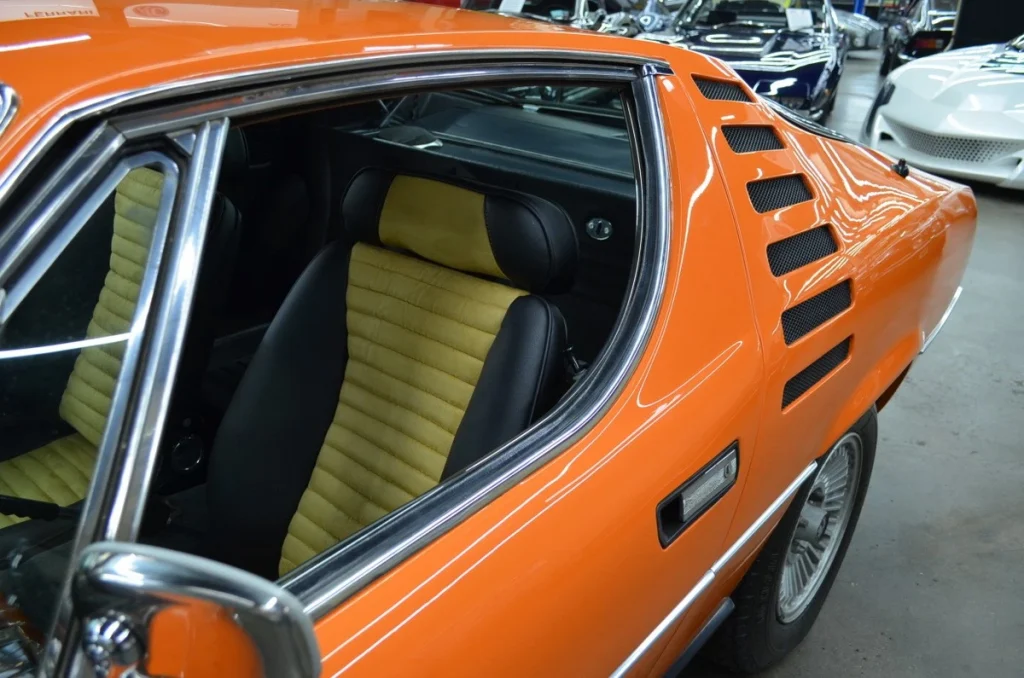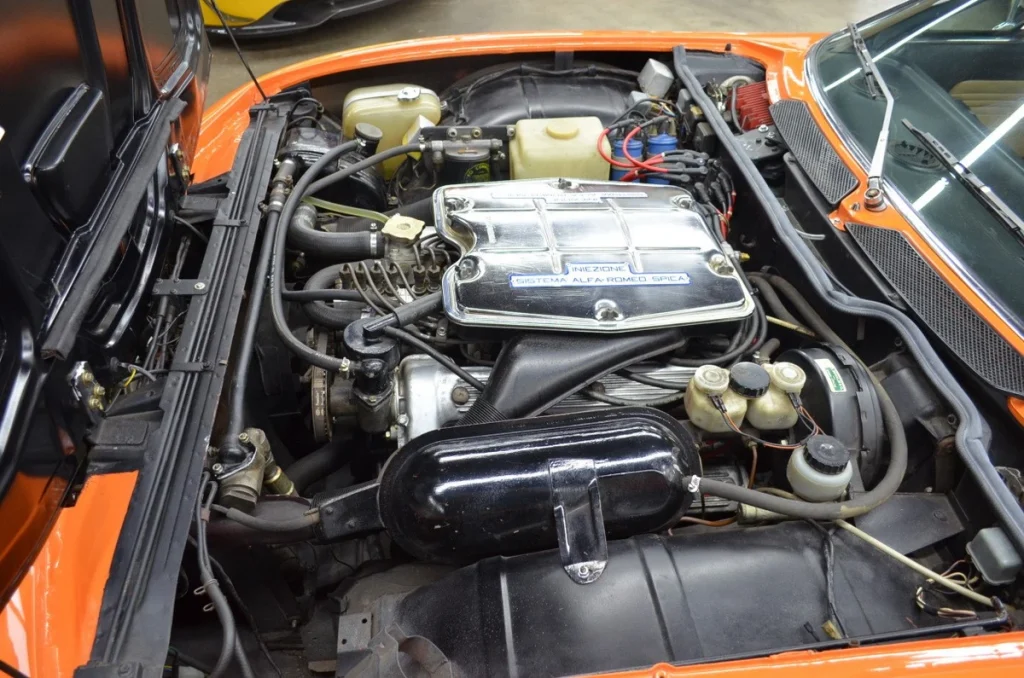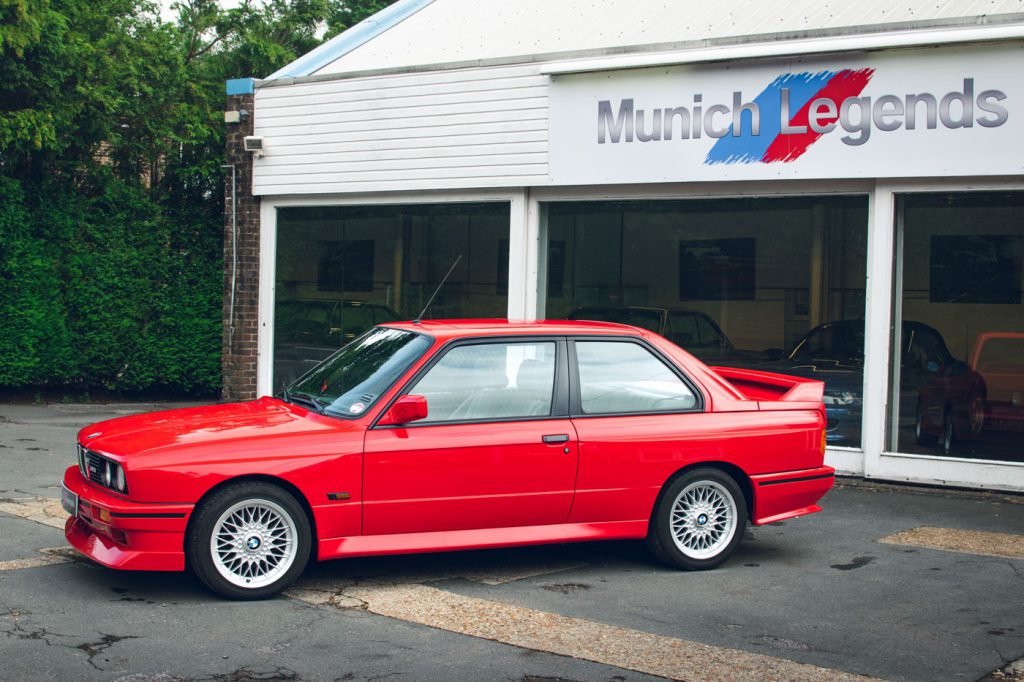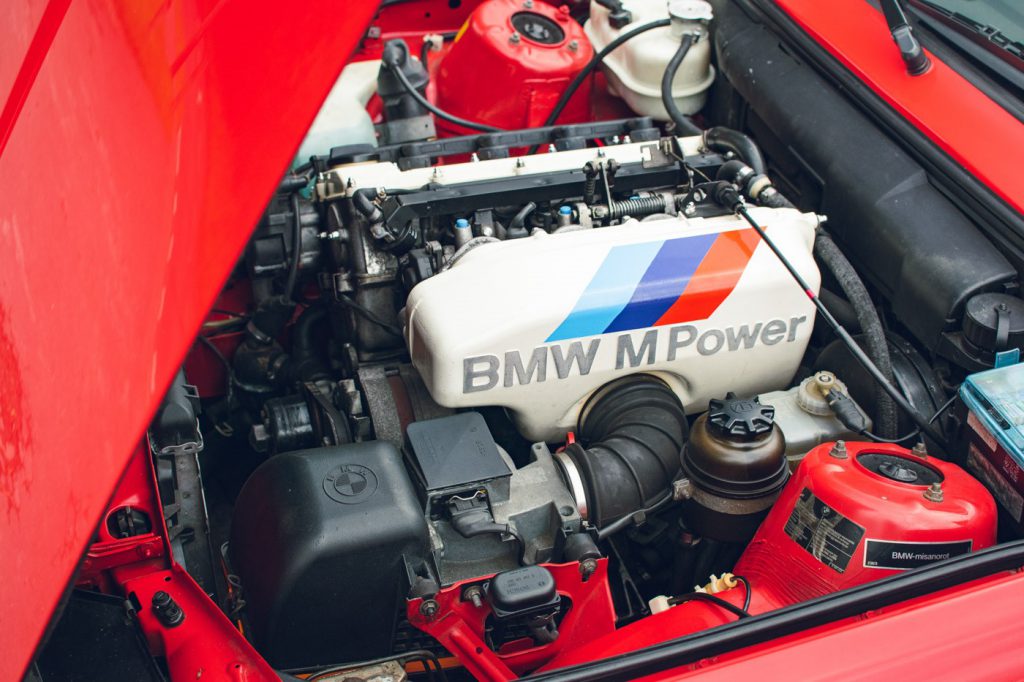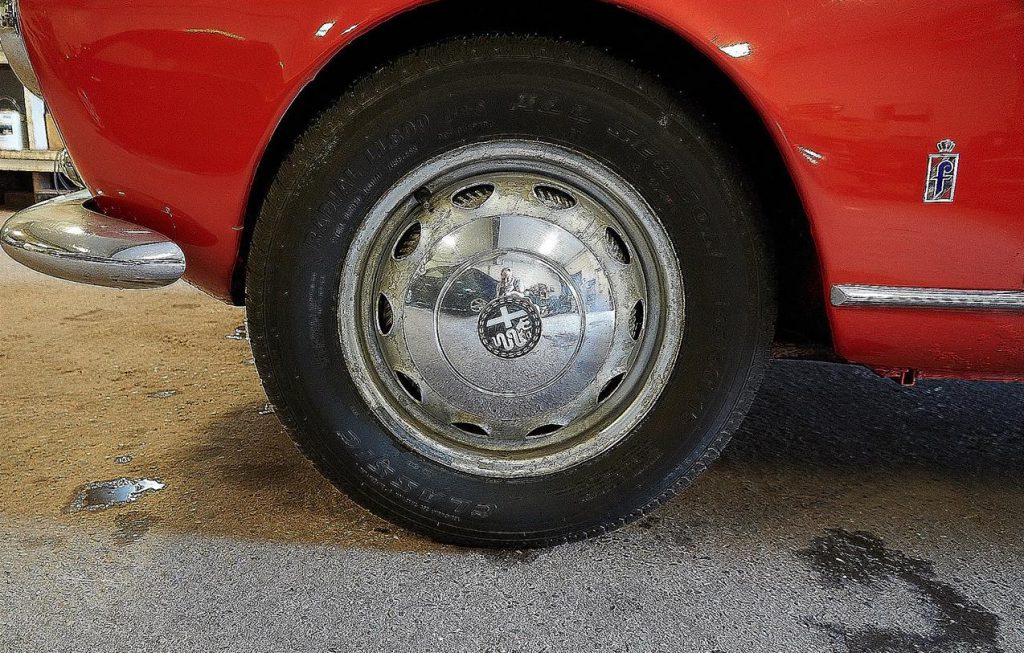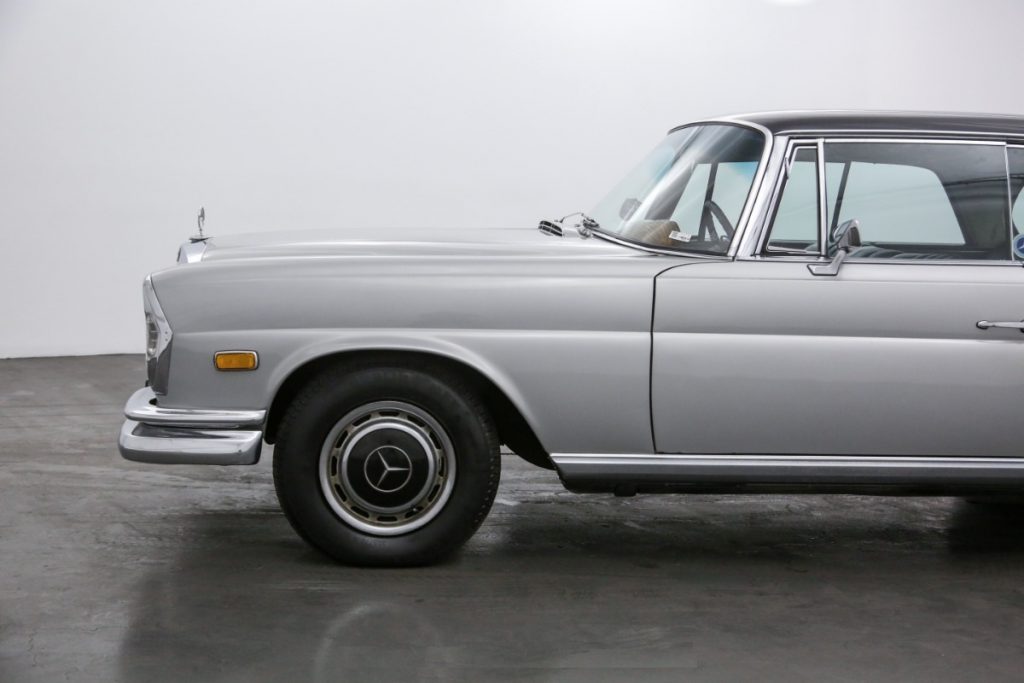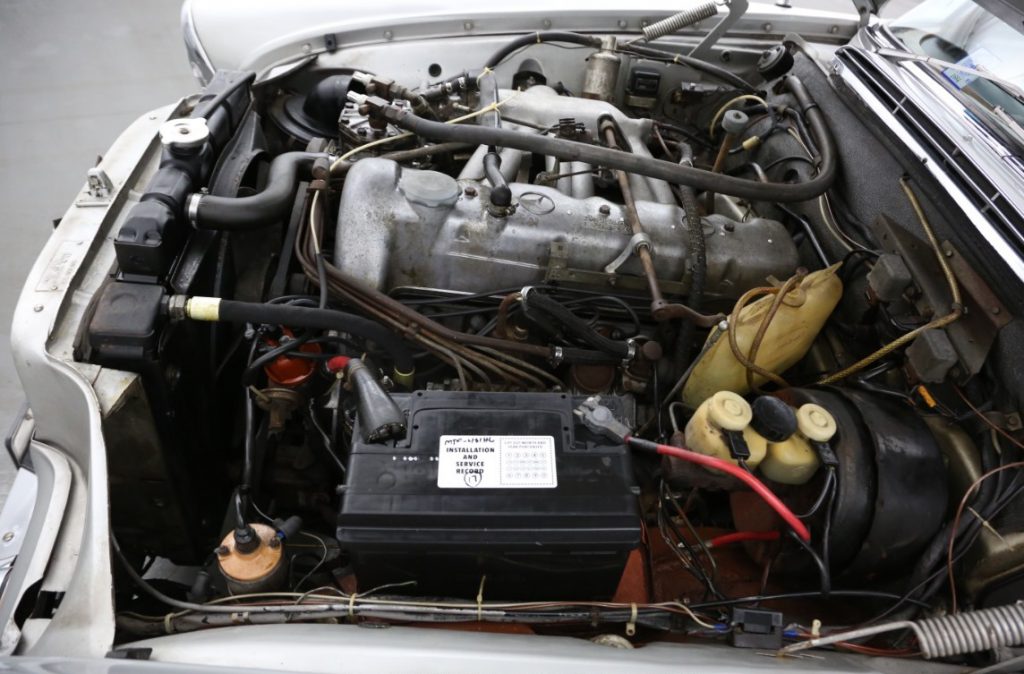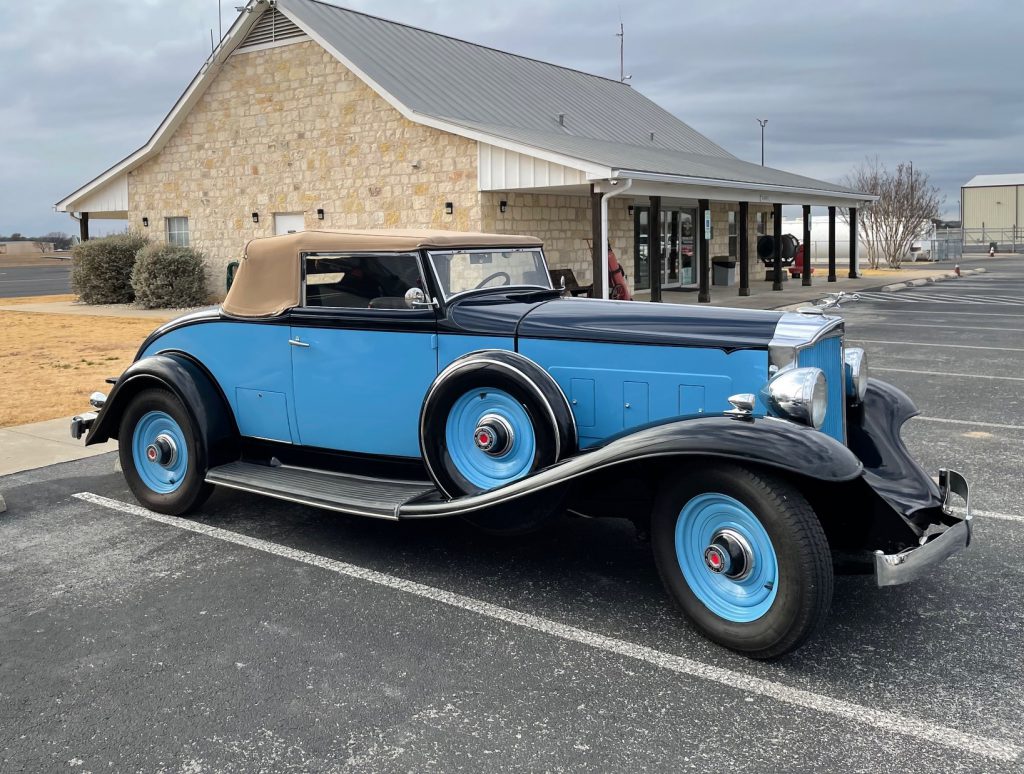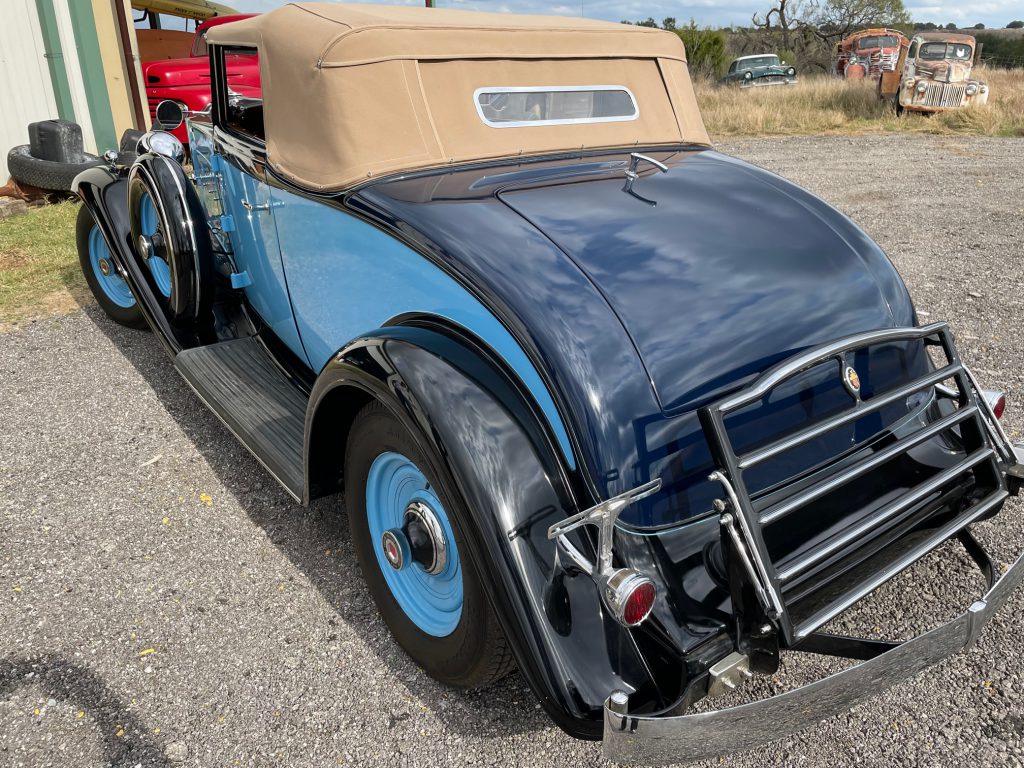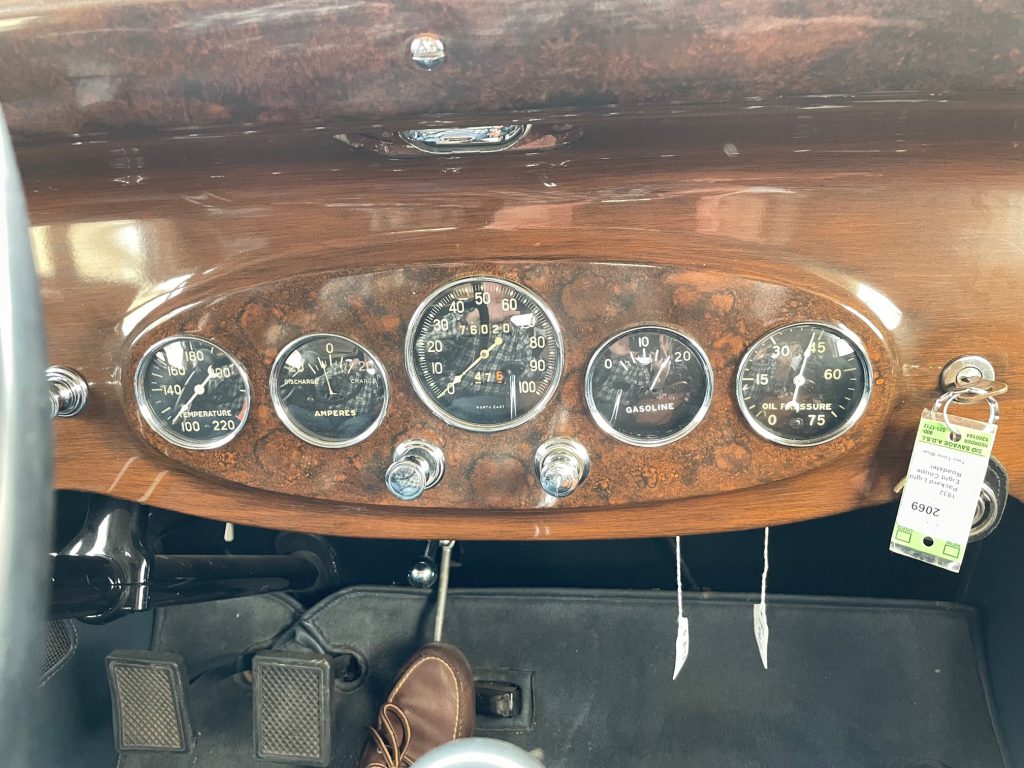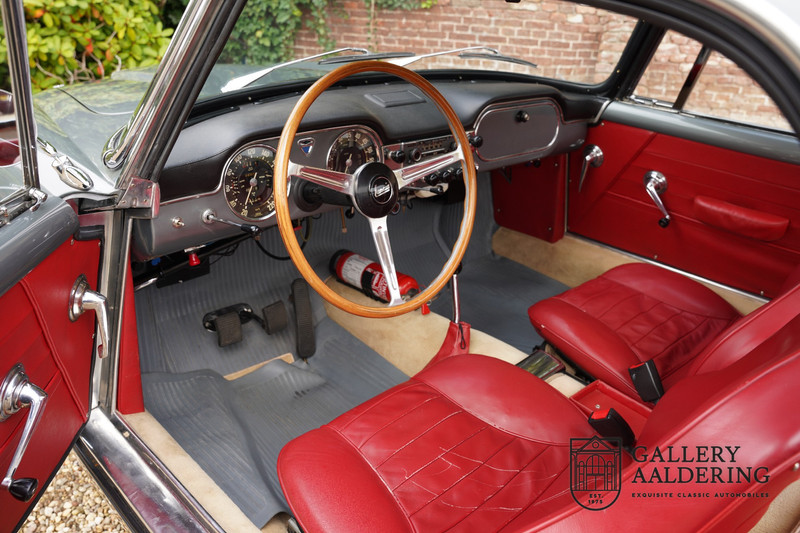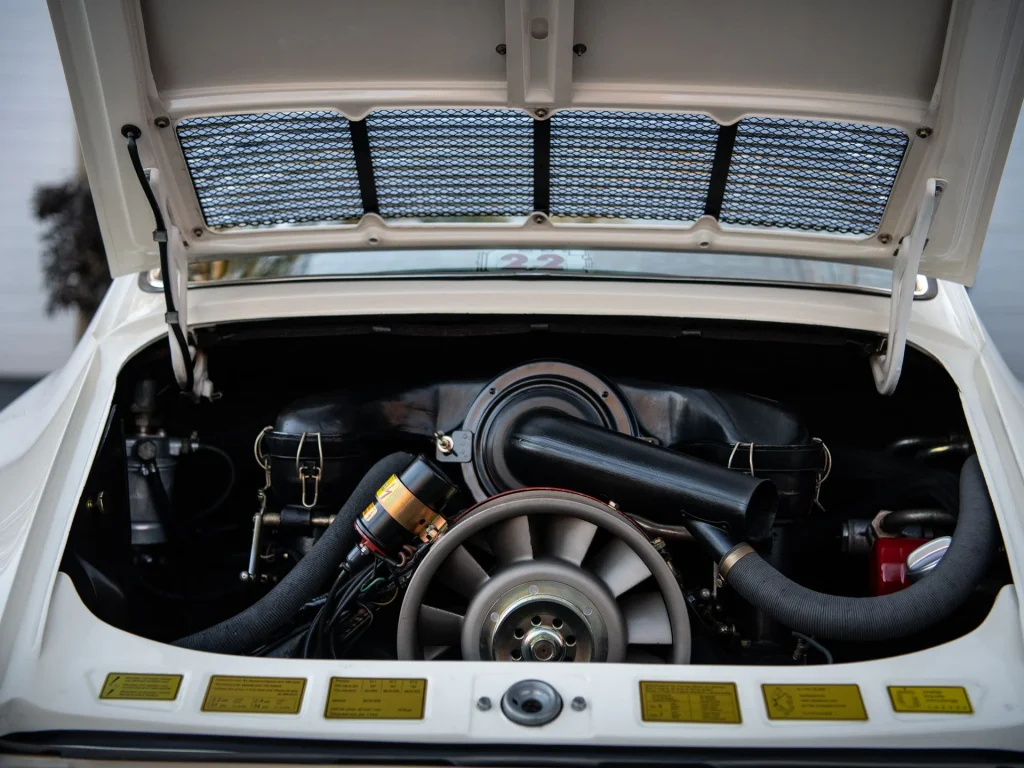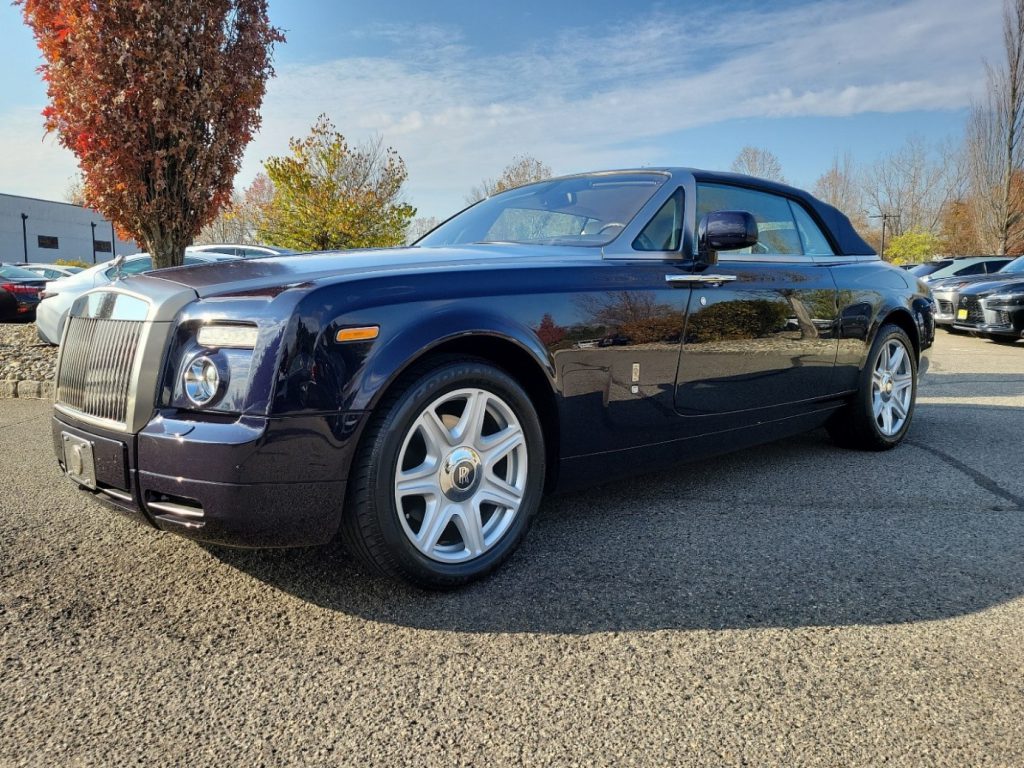Jim's Cars
1968 Ford Mustang GT California Special
- Built: 1968
- From: Alberta, Canada
- Engine: 390 cu-in V8
- Power: 325 hp
- Torque: 427 lb-ft
- Weight: 3060 lbs
- 0 to 60 mph: 7.0 sec
This Ford Mustang GT is one of 4,118 examples ordered with
1968-only California Special equipment, and was built in San Jose, California,
for sale at Dunlop Ford of Lethbridge, Alberta. The car was acquired by its
current owner in 2011 and subsequently underwent a refurbishment that included
a repaint in its factory Sea Foam Green. Power comes from a replacement 390ci
V8 paired with a four-speed manual transmission, and equipment includes chrome
14″ GT wheels, a rear spoiler, faux side scoops, fog lights, black vinyl
upholstery, and an AM radio. This California Special coupe is offered on dealer
consignment in Canada with refurbishment records and photos, a reproduction
window sticker, an Elite Marti report, and Alberta registration.
The car was mounted to a rotisserie for body repairs and
refinished in its factory shade of Sea Foam Green as part of the refurbishment.
Details include white GT/CS stripes, a special fuel cap, a retractable antenna,
hood vents and exposed locks, a fiberglass rear spoiler, quarter panel
extensions, and a revised taillight panel.
Chrome-finished 14″ GT steel wheels with beauty rings are
wrapped in F70-15 Firestone Wide Oval raised white-letter tires. Stopping is
handled by power-assisted front disc and rear drum brakes.
The cabin features front bucket seats and a rear bench
trimmed in black vinyl along with a matching dashboard, door panels, and
carpets, the latter of which are protected with Mustang-branded floor mats.
Equipment includes a glovebox, an AM radio, lap belts, and a heater.
The optional Deluxe steering wheel frames a 120-mph
speedometer and a tachometer as well as fuel and coolant temperature gauges.
The five-digit odometer shows 55k miles, approximately 400 of which have been
added by the previous owner. Total mileage is unknown.
The 390ci V8 is said to use a replacement block that was
fitted early in the car’s life. The engine features a four-barrel carburetor
and was rated at 325 horsepower and 427 lb-ft of torque when new.
Euro 1971 BMW 3.0CSi 5-Speed
- Built: 1971
- From: Vöhringen, Germany
- Engine: 3.0 liter inline-6
- Power: 197 hp
- Torque: 200 lb-ft
- Weight: 3131 lbs
- 0 to 60 mph: 7.4 sec
This 1971 BMW 3.0CSi is a European-specification example that is said to have been first delivered to Beilharz BMW of Vöhringen, Germany, and reportedly underwent a mechanical and cosmetic refurbishment prior to 2018. The car is finished in blue over tan cloth upholstery and powered by a numbers-matching 3.0-liter inline-six paired with a five-speed manual transmission. Equipment includes 16″ Alpina wheels, a sunroof, power windows, four-wheel disc brakes, air conditioning, and polished exterior trim. This E9 is now offered in Leipzig, Germany, with the removed factory wheels with tires and German registration.
After an extended period of storage, the body is said to have been taken down to bare metal prior to a repaint in the factory Baikal Metallic (042) under prior ownership. Equipment consists of polished trim, chrome bumpers with black impact strips, and a single exhaust outlet.
Alpina 16″ alloy wheels are mounted with a mixed set of Goodyear and Continental tires. Stopping power is provided by four-wheel disc brakes. The factory-installed 14″ wheels with roundel center caps mounted with Maxxis were included with the sale.
The manually-adjustable seats are trimmed in tan cloth and are joined by matching door panels and brown carpets. Equipment includes a push-button BMW Bavaria radio, air conditioning, wood trim accents, power windows, and a sunroof.
An Alpina three-spoke steering wheel frames a 240-km/h speedometer, a tachometer, a clock, and auxiliary gauges. The five-digit odometer shows 63k kilometers (~39k miles).
The numbers-matching 3.0-liter M30B30 inline-six features an aluminum cylinder head and Bosch D-Jetronic fuel injection. The engine was reportedly resealed under prior ownership and was factory rated at 197 horsepower and 200 lb-ft of torque.
1973 Alfa Romeo Montreal
- Built: 1973
- From: The Netherlands
- Engine: 2.6 liter V8
- Power: 200 hp
- Torque: 173 lb-ft
- Weight: 2800 lbs
- 0 to 60 mph: 8.0 sec
The Montreal is one of the most sophisticated and striking post-war Alfa Romeo production cars. It uses a detuned version of the quad-cam, fuel-injected, dry sump V8 used in the legendary Tipo 33 prototype racecar. The Montreal has a Spica mechanical fuel injection system, a five-speed ZF manual gearbox, front independent suspension, a live rear axle with coil-spring suspension, four-wheel disc brakes and a chassis derived from the iconic 105-series cars. Designed by Bertone, the Montreal was wide and low with a shark-like nose extending through a curved fender and shoulder haunches into a truncated tail. The headlight “blinds” and stacked horizontal vents on the C-pillar were rather attractive and very futuristic at the time. The V8 produces 200bhp taking only 7.1 seconds to get to 60mph and reaching 140mph back in 1971! Besides its stunning looks, the Montreal is practical with a 2+2 seating configuration and a full trunk enclosed by a glass hatchback.
Orange, Black interior with Beige cloth inserts, Black dashboard, Grey carpeting, Restored, 2.6 Liter V8 engine, 5-speed manual gearbox.
This Montreal was sold new to its first owner in The Netherlands in February 1973. It was reportedly with the original owner until 1989 when sold to its second owner also in The Netherlands. History resumes in 2017 when acquired by its next custodian. This owner entrusted Italclassic of Alicante, Spain to carry out restoration work. This included refinishing the exterior in orange, refreshing the interior, tuning the fuel-injection system, and installing a new exhaust system and jacking points. In 2018 Alfa Romeo specialist, Sam Van Lingen of the Netherlands, installed new fuel injectors and set the valve clearance. The Montreal also received new fluids, filters, and hoses along with an upgraded water pump.
The Montreal was then sold in 2019 and imported to its previous owner in California.
A truly iconic sports car, this Alfa is comfortable, yet dialed in for around-town or long highway cruising. A recent road test attests to the car performing excellent in every way and it is ready for immediate use and enjoyment. The engine pulls extremely well with plenty of horsepower and torque, the mechanical injection is set up properly and the gearbox and clutch feel as new.
With just 3,925 examples built between 1971 and 1977, this Montreal is both rare, exotic and a lot of fun to drive and worthy of a place in any collection. This Montreal is complete with its original service book, original Netherlands registrations, spare tire and recent service records.
1988 BMW E30 M3 Evo II
- Built: 1988
- From: England
- Engine: 2.3 liter inline-4
- Power: 217 hp
- Torque: 180 lb-ft
- Weight: 2646 lbs
- 0 to 60 mph: 6.4 sec
One of only 500 M3 Evo IIs produced, this is a very rare special edition of the M3.
In the mid-1980s, BMW tasked its Motorsport Division with homologating the E30 3 Series for Group A racing in Europe. Group A specs allowed minimal changes from cars produced in production runs of 5,000 units built for street use, so BMW’s M division reengineered almost every aspect of the 3 Series platform for a large production run. What emerged was the radically styled box-fendered M3 in 1986, with the hood and roof being the only bodywork shared with the standard 3 Series coupe.
Underneath the M3’s flared fenders was a thoroughly reworked front suspension as well as new BBS wheels, larger brakes, and larger tires. The 2.3-liter S14 motor started with a block similar to the one used in the 320i, and added a 16-valve head to produce 192 hp in North American trim. This free-revving powerplant motivated the M3 to the tune of a sub-7-second 0-60 dash and a 146-mph top speed that complemented its neutral and confidence-inspiring handling.
Almost 15,000 first generation M3’s were built from 1986-1992, with just over 5,000 coming to the U.S. from the middle of 1987 (as 1988 model year cars) until the end of 1991. Throughout the production run there were a myriad of changes to interior and exterior colors, and in 1990 changes to the North American cars included aluminum control arms, a driver’s side airbag, and the option of a glass sunroof.
Collectors should note that a very small number of E30 M3 convertibles made it to North America, as well as a handful of Euro-spec cars that can be identified by their differing transmission and shift pattern that includes a dog-leg first gear. Various special editions were available in Europe that included Evo I, Evo II, and Lightweight cars that were not offered in the U.S.
The Evo II featured the S14 engine with 30 more horsepower than the already powerful M3, delivering a whopping 217hp, the highest output 2.3L BMW used in the 3 series for homologation. The Evo II sported BBS cross-spoke 16” x 7.5” wheels, was outfitted with thinner weight saving rear and side glass, a lighter trunk lid, a deeper front spoiler, lightened bumpers, and a unique rear spoiler. The resulting refinements were impressive from a performance perspective, but also delivered a memorable visual impression, one that continues to impress collectors and enthusiasts seeking performance, comfort, and distinctive design in a purpose-built touring car.
1995 BMW E31 850CSi
- Built: 1995
- From: USA
- Engine: 5.6 liter V12
- Power: 375 hp
- Torque: 406 lb-ft
- Weight: 4112 lbs
- 0 to 60 mph: 5.5 sec
As a top-of-the-range variant of the 8 Series, the 850CSi took over from the prototype M8 variant. The 850CSi used the same engine as the 850i, which was tuned so significantly that BMW assigned it a new engine code: S70B56. The modifications included Bosch Motronic 1.7 fuel injection, a capacity increase to 5,576 cc (5.6 L) and power increase to 375 hp at 5,300 rpm and 406 lbf⋅ft of torque at 4,000 rpm. Road & Track recorded a 0-60 mph (0–97 km/h) time for the 850CSi of 5.9 seconds.
The 850CSi’s modified suspension included stiffer springs and dampers that reduced the car’s ride height. The recirculating ball steering ratio was dropped 15% over the standard E31 setup. The model also sported staggered throwing star wheels. The front and rear bumpers were reshaped for improved aerodynamic performance. Four round stainless steel exhaust tips replaced the square tips found on other models. The 6-speed manual gearbox was the only transmission option. In Europe, all 850CSi’s came with four-wheel steering (AHK – Aktive Hinterachs-Kinematik, Active rear axle Kinematics), upgraded and ventilated brakes with floating front discs, rear differential oil cooler, engine oil cooler, two-tone interior, sports seats, and reshaped mirrors. In the United States, the cars instead received “BMW Motorsport” writing on the doorhandles.
Production ended in late 1996 because the S70 engine could not be modified to comply with new emission regulations without substantial re-engineering.
This particular model had 3 previous owners. Original MSRP was $104,650. This car has a very late production date of June 8th, 1995. This E31s VIN ends in CD00227, whereas CD00230 was the last NA-Spec production 850CSi. One of only 225 examples produced for North America. The condition of this E31 is impeccable! All original body panels and the exterior paint is mostly original; the driver side and passenger rear quarter have higher paint meter readings. The paint quality is immaculate with a deep, glossy finish with no significant cosmetic disclosures or blemishes! The interior is well-preserved with supple leather upholstery, clean carpets + smooth plastic trim showing no wear areas or issues. This 850CSi has never been exposed to winter conditions. BMW Factory Options Include: Power Front Seats with Adjustable Lumbar Support and Driver Memory, Power Door Locks, Mirrors and Windows, Power Sliding Sunroof, Keyless Entry with Factory Alarm, Full On-Board Computer, Air Conditioning, Cruise Control, 6-CD Changer with HiFi Speaker System.
1968 Ferrari 365 GT 2+2
- Built: 1968
- From: ?
- Engine: 4.4 liter V12
- Power: 320 hp
- Torque: 308 lb-ft
- Weight: 3223 lbs
- 0 to 60 mph: 6.7 sec
The 365 GT 2+2 was launched at the Paris Salon in October 1967. Sleekly styled in the manner of the limited-edition 500 Superfast, the 365 GT 2+2 was the most refined Ferrari to date.
Based on the contemporary 330 GTC, the chassis was made of Ferrari’s familiar combination of oval and round steel tubing. Developing 320 hp in its 365 GT incarnation, the well-proven 4.4-liter V12 engine was coupled to a 5-speed gearbox, and the car’s blistering performance (top speed 150 mph, 0-60 mph in 7 seconds) was restrained by Girling ventilated discs all around. Endowed with an unusual combination of fine handling and a supple ride, the 365 GT 2+2 Coupe was rated by Car magazine as “the most civilised Ferrari yet.”
1962 Alfa Romeo Giulietta
- Built: 1962
- From: ?
- Engine: 1.8 liter inline-4
- Power: 78 hp?
- Torque: 78 lb-ft?
- Weight: 1900 lbs
- 0 to 60 mph: 13.2 sec
Until the early 1950s, Alfa Romeo was a large engineering company that also produced a small number of high luxury motor vehicle chassis, practically made by hand, with the bodywork fitted externally. The company already began changing skin with the 1900, turning itself into a regular automobile manufacturer with the mass production of complete vehicles. However the model that truly established the transformation was the Giulietta with just 1300 CC.
With the Giulietta, Alfa Romeo entered a new market segment – that of sports vehicles with medium-small displacement: a segment that practically concurred with the Portello brand for three decades. The Giulietta is, therefore, possibly the most important of all the Alfa Romeo vehicles, the progenitor of an infinite series of models that have conquered markets all over the world: despite being based on a solid prior tradition, it is the model on which Alfa’s success rests. Launched in 1954 in the Coupé version, it was then produced in a Spider and Saloon version. The bodywork of the Coupé was designed by Bertone, who also took care of the fittings: the body shells were then transported to Milan for the assembly of the mechanical parts and finishings.
Derived from vehicles that were between a racing car and the prototype, the Giulietta Coupé was and is a masterpiece of its genre: snug and streamlined, with a clean and perfectly proportioned line that was a trailblazer. It was so successful that it was produced without variation for more than a decade, even passing on to the subsequent model, the Giulia.
1968 Mercedes 280SE
- Built: 1968
- From: ?
- Engine: 2.8 liter inline-6
- Power: 180 hp
- Torque: 193 lb-ft
- Weight: 3329 lbs
- 0 to 60 mph: 9.6 sec
The Mercedes-Benz W113 SL was developed under the direction of Mercedes-Benz Technical Director Fritz Nallinger, Chief Engineer Rudolf Uhlenhaut, and Head of Styling Friedrich Geiger. The lead designers were Paul Bracq and Béla Barényi. The design featured the patented, slightly concave hardtop, which inspired the ‘Pagoda’ nickname. The model was in production from 1963 through 1971 and was powered by an in-line six-cylinder engine with multi-port fuel injection. The larger capacity 280, with the 2.8-liter engine, was introduced in 1967.
The Mercedes-Benz fifteen ‘New Generation’ models were publicly displayed for the first time at the Frankfurt Auto Show in 1967 and went on sale the following January. It remained largely unchanged until 1971. The 280 SE fuel-injected saloon shared the bodyshell with the ‘New Generation’ 280 S, however, the 280 SE Coupe and Convertible retained the looks of the outgoing 250 SE that had been introduced in 1959 on the 220 SE, designed by Paul Bracq. The all-new Type M130 engine was an overhead-camshaft six-cylinder unit with a 2,778cc displacement. With the help of the fuel-injection system in the ‘SE’ form, the seven-bearing M130 delivered 160 horsepower at 5,500 RPM. Transmission options included a manual or an automatic. The suspension system was essentially the same as the equivalent saloon model but with a lower ride height. Disc brakes at all four corners provided the stopping power.
One of the benefits of the fuel-injected M130 engine was its fuel economy and emissions control.
The 1968 Mercedes-Benz 280 Series was available as a sedan, coupe, or convertible and was powered by an overhead-cam six-cylinder engine with two carburetors and delivered 157 horsepower. The 280SE, 280SL, and 280SEL versions received the same engine but with a 9.5:1 compression ratio and Bosch fuel injection system and delivered 180 horsepower. A four-speed manual was standard with an automatic available as optional equipment.
The interior featured a leather-covered dashboard and most examples had leather upholstery. There was a Becker radio, and round speedometer and rev counter flanking vertically stacked gauges. The padded convertible top was manually operated. The list of options included central locking and power-assisted steering, electric windows, and air conditioning.
1932 Packard Light Eight
- Built: 1932
- From: Auburn, Indiana
- Engine: 5.2 liter inline-8
- Power: 110 hp
- Torque: 193 lb-ft
- Weight: 3990 lbs
- 0 to 60 mph: 23.0 sec
The Packard Ninth Series Light Eight Model 900 was an automobile model produced by the Packard Motor Car Company of Detroit, Michigan only during model year 1932. The Light Eight was planned as a new entry model, building off the 1928 Packard Six. It competed in the upper middle-class with makes like GM’s Companion Brand LaSalle, Marquette and Chrysler’s DeSoto, and the top-level products from Studebaker, Hudson, and Nash. The marketing objective was to add a new market segment for Packard during the depression.
Packard did not use yearly model changes in these years. A new series appeared when management felt that there were enough running changes made. Therefore, the Light Eight was introduced during January 1932, together with the new V-12 (called “Twin Six” in its first year to honor the pioneer Packard model built from 1915 to 1923). Standard Eights and Super Eights followed in June 1932.
This particular car is blue and black over a blue interior, has a tan convertible top, dual side-mounted spares, and has both a rumble seat and luggage rack. The richly finished wood dashboard features a suite of gauges and a clock. During restoration, it was fitted with a modern alternator for improved charging. Additional upgrades include an electric fuel pump and modern radiator with an electric fan. Car was accompanied by restoration receipts, publications by Packard, sales material, and manuals.
1966 Porsche 912
- Built: 1966
- From: ?
- Engine: 1.6 liter flat-4
- Power: 90 hp
- Torque: 91 lb-ft
- Weight: 2127 lbs
- 0 to 60 mph: 11.4 sec
Irish Green with Black leatherette interior, Grey German square weave carpeting, showing 76,000 original Kilometers, Complete nut and bolt rotisserie restoration, 5-speed gearbox, Original owner’s manual, warranty booklet, tool roll, spare tire and Porsche Certificate of Authenticity.
Factory Options include: Ventilated Chrome Wheels, Headrest in Leatherette, Bumper Horns F/R, Tinted Windshield and Rear Window, Antenna, Wheel Caps w/ Crest, Driver and passenger Safety Belts – Lap, Wood Steering Wheel, Signal Key, Outside Thermometer, Time Clock, Kleber Colombes Tires.
Porsche launched the 911 in 1965 and although it had yet to become a class-leading icon, the 911 was rather expensive. Porsche expanded their market by offering the same body style, but with a 4-cylinder engine which Porsche could sell as their entry level model, known as the 912. The 912 had less power than the 911, however it carried less weight and remained a well-balanced car with excellent road manners. Porsche offered the 912 with standard 4 or optional 5 speed manual transmission, this particular 912 received the optional 5 speed.
This 912 Coupe has been immaculately restored. It was brought back to showroom finish, with its stock appearance being maintained, even displaying its rare optioned factory Ambient Temperature gauge, part of this rare 5-gauge cluster 912. It sits in its original livery of Irish Green over Black. It is complete with its original owner’s Manual, warranty booklet, tool roll and spare tire. Also included is the Porsche Certificate of Authenticity, as well as an enormous history file which records for service, restoration and ownership history. The restoration alone has over 800 photos of its rotisserie restoration.
1962 Lancia Flaminia GT Touring 2.5 3C
- Built: 1962
- From: ?
- Engine: 2.5 liter V6
- Power: 140 hp
- Torque: 156 lb-ft
- Weight: 2976 lbs
- 0 to 60 mph: 10.2 sec
Few carriage builders have such an impressive list of designs to their name as Carrozzeria Touring. From the BMW 328 Mille Miglia to the Alfa Romeo C53 Disco Volante, the Ferrari 166 MM and Inter to the Lamborghini 350 GT. There is yet another rare beauty to add to this list: the fine Lancia Flaminia GT Touring.
Slender, slim, stylish; a typical early 60’s Italian coupé. Touring took the ‘normal’ Flaminia and shortened the chassis and so designed a timeless beauty whether it is the open or closed variant. For many a car lover the GT, the fractionally longer GTL as well as the convertible still feature high on the list of the most beautiful cars ever built.
This wonderful 1962 GT 2.5 3C has a subtle grey finish which goes by the name of Grigio Newmarket Metallizzato. A stunning, older restored car. The Lancia therefore still presents in peak condition. The bodywork is pristine. The nice and thin, correctly aligned panelwork is adorned with lots of shiny chrome make this coupé a sensationally eye-catching affair from every angle.
Inside is at least as stylish as the exterior. Gorgeous red leather in perfect condition and patinaed, it does not get much better. Seated you face two enormous gauges in typical Lancia fashion. They are visible through the large wooden steering wheel. The dashboard has a near symmetrical form, with a centrally placed Becker Mexico radio, perfectly matched to the rest of the interior.
The car has a 2.5 litre V6 with three carburettors, hence the models ‘3C’ annotation. The engine is a further development of the Aurelia’s 2.5 litre V6. The engine develops 140 hp and delivers a very sportive ride. The V6 is attached to a 4-speed gearbox that according to the transaxle-principal is situated between the rear wheels.
2003 BMW E46 M3
- Built: 2003
- From: Regensberg, Ger
- Engine: 3.2 liter inline-6
- Power: 333 hp
- Torque: 262 lb-ft
- Weight: 3415 lbs
- 0 to 60 mph: 5.4 sec
The BMW M3 E46 Coupé took the hearts of real sports car fans by storm when it launched in 2000. With a low weight construction and the high-rev concept of its inline 6-cylinder engine, for many it embodied a return to the virtues of the iconic BMW M3 E30. The following year, a convertible followed, combining a sporty experience and the luxury of open-top driving in an unprecedented way.
An M automobile never lacks for clear distinguishing features. As with the iconic M3 E30, the M3 E46 is immediately recognizable as the premium model in its series thanks to numerous details. In particular, aesthetic changes such as widened fenders, special side skirts and the modified front apron catch the eye of every observer. These changes also serve an important purpose, mostly in terms of aerodynamics. This also applies to the so-called Gurney flap at the rear: the small spoiler lip noticeably reduces lift and thus improves to traction – crucial in faster corners.
From a side profile, the E46 M3‘s chrome-plated gills in the upper part of the front fender are a standout feature. These were originally designed as an air duct for cooling the engine. During testing, however, it turned out that the ducts were not necessary. Nevertheless, they remained – and became such an iconic highlight that their appeal extended beyond just fans of BMW M. Not to be missed are the special side mirrors, which are aerodynamically-shaped to cut through the air. The so-called powerdome, the clearly recognizable curvature of the bonnet, created space for the engine’s powerful intake system. The design of the hood left no doubt that there was a real powerhouse hidden under it.
1988 BMW E28 M5
- Built: 1988
- From: England
- Engine: 3.5 liter inline-6
- Power: 286 hp
- Torque: 251 lb-ft
- Weight: 3186 lbs
- 0 to 60 mph: 6.4 sec
The first generation of the BMW M5 came out on the market in 1985 and its main weapon was highly concealed under a bodywork that looked the same as on a basic 5-Series with nicer wheels.
By the time when the second generation of the BMW 5-Series was launched, the whole company design language was established, with the shark-nose profile for the whole range. The first vehicle which featured that front profile was the 7-Series and it was followed by the 6-series. The development for the second generation started in 1985 and it involved the spare-parts department and the accounting computer. It was the only computer in the company.
The E28 5 Series was launched in 1981 and it was a simple, four-door sedan. It was meant to be a car for the premium customers, with decent performance and better handling than the competition, mainly the Mercedes-Benz. In 1984, the M 535 I was launched, and it was a commercial success with its 218 hp engine. But that was not all. The four-door sedan was improved once again in 1985 with the first, true, M5. It featured the M88/3 engine, which was used on the 3.0 CSL race-car and in the famous BMW M1. The twin-cam, 24 valves unit offered 286 hp and that was only a part of what the M5 could offer. A 5-speed manual transmission was the only option.
From the outside, only a few clues would tell the difference. There were a special bumper, side-sills, and a rear deck-spoiler. On the grille, a small M5 badge was installed as well as in the rear. Special BBS light-alloy wheels were standard for the top-model. At the time of the launch, it was the fastest 4-door sedan in the world.
1971 Porsche 911S
- Built: 1971
- From: California
- Engine: 2.2 liter Flat 6
- Power: 180 hp
- Torque: 147 lb-ft
- Weight: 2249 lbs
- 0 to 60 mph: 7.8 sec
A ‘modern classic’ if ever there was one, Porsche’s long-running 911 arrived in 1964, replacing the 356 that had secured the fledgling company’s reputation as producer of some the world’s finest sporting cars. The iconic 911 would take this reputation to an even more exulted level on both the road and racetrack.
Porsche’s long-running and much loved 911 sports car first appeared at the 1963 Frankfurt Show as the ‘901’, but shortly after production proper commenced in 1964 had become the ‘911’ following Peugeot’s complaints about the use of ‘0’ model numbers. The preceding Type 356’s rear-engined layout was retained but the 911 switched to unitary construction for the bodyshell and dropped the 356’s VW-based suspension in favour of a more modern McPherson strut and trailing arm arrangement. In its first incarnation, Porsche’s single-overhead-camshaft, air-cooled flat-six displaced 1,991cc and produced 130bhp; progressively enlarged and developed, it would eventually grow to more than 3.0 litres and, in turbo-charged form, put out well over 300 horsepower.
The first of countless upgrades to the perennial 911 came in 1966, two years after production had commenced, with the introduction of the 911S. Easily distinguishable by its stylish Fuchs five-spoked alloy wheels, the ‘S’ featured a heavily revised engine producing 160bhp. Improved handling courtesy of a lengthened wheelbase arrived in 1969, and then in 1970 the 911’s air-cooled, flat-six engine underwent the first of many enlargements – to 2.2 litres – in which form it produced 180bhp on Bosch mechanical fuel injection when installed in the top-of-the-range ‘S’ model. By this time the models on offer had stabilised at three: the 911T, 911E, and 911S, all of which were available as either a closed coupé or Targa convertible. With the 2.2-litre engine’s arrival, a common type of cylinder head was adopted, the differing power outputs being determined principally by valve timing rather than valve sizes as had been the case hitherto. In total 1,420 coupé and 788 Targa convertible 2.2-litre ‘S’ models were sold worldwide.
2010 Rolls Royce Phantom Drophead Coupe
- Built: 2010
- From: New Jersey
- Engine: 6.7 liter V-12
- Power: 453 hp
- Torque: 531 lb-ft
- Weight: 5776 lbs
- 0 to 60 mph: 5.5 sec
The 2010 Rolls-Royce Phantom Drophead Coupe is a two-door convertible version of the Rolls-Royce Phantom. Although 10 inches shorter than the standard Phantom, the Drophead Coupe is still 20 inches longer than an Audi Q7 and only 2 inches shorter than a Suburban. It weighs more than both. The Drophead is also incredibly wide, which makes maneuvering in tight spots akin to piloting a large yacht through a lazy river.
The Drophead is special in plenty of other ways as well. Most notable are the rear-hinged “coach” doors that have essentially been extinct on two-door cars since the 1930s. Of course, only the finest materials have been used to create a truly one-of-a-kind cabin. No fewer than 18 bovines sacrifice themselves for king, country and interior. The interior color of this model is called “creme light”
The Drophead Coupe stands apart with a special optional tonneau cover for the five-layer soft top (available in six colors itself) that is finished in 100-percent genuine teak and is said to resemble the deck of a luxury yacht. Rolls sources blonde green teak grown in hilltop regions of Southeast Asia. Each “deck” features 30 separate pieces cut from the same tree to avoid any variation in grain patterns. Those pieces are bonded, then black caulking (the same as yacht builders use) is applied to the grooves before the entire deck is sanded and finished. It’s recommended that the teak be oiled at every service interval. Sound impossibly high-class? It bloody well is and you should order it.
There’s a car under all this pomp and circumstance, and we’re happy to report it’s a mighty fine one. Meticulously engineered by BMW and Rolls-Royce, the Phantom Drophead Coupe perfectly blends the dynamic virtues of a modern German car with the style and panache expected of a classic British luxury automobile. The power from its V12 is vigorous, its ride is supple, its handling surprisingly un-yachtlike. There are other high-end luxury convertibles, but none can truly stand toe to toe with the 2010 Rolls-Royce Phantom Drophead Coupe.
The Rolls-Royce Phantom Drophead Coupe is powered by a 6.7-liter V12 that produces 453 horsepower and 531 pound-feet of torque. A six-speed automatic transmission sends that massive power to the rear wheels. Rolls-Royce estimates that the Drophead will go from zero to 60 mph in 5.7 seconds. Fuel economy is likely to be better than your yacht’s.
Safety equipment includes run-flat tires, antilock brakes, traction and stability control, a pop-up rollover protection system, active front head restraints, front knee airbags, front side airbags and Rolls-Royce emergency telematics. Front and rear parking cameras are optional.
Big. That’s the best word to describe the 2010 Rolls-Royce Drophead Coupe, a vehicle that is enormous in every dimension despite being 10 inches shorter than its sedan comrade. As such, piloting it through tighter streets can be daunting, with its wide body and huge front end perched in the distance like the bow of a ship (the Spirit of Ecstasy perched atop the grille may start to look like Leo DiCaprio yelling, “I’m king of the world!”). Thankfully, the optional split-view front camera provides a left-right side view of crossroads ahead.
Given its size, the Drophead is definitely happiest out on the open road, dominating high-speed thoroughfares like a road-going ocean liner. The ride is smooth but not floaty, absorbing broken pavement with nothing but muted thumps, and the open-roof structure feels impressively rigid. You could probably hit a land mine and barely notice. Unlike with other convertibles — especially large ones — there is no body flex or creaking, which perpetuates the feeling of spectacular, indestructible quality.
Believe it or not, the 2010 Rolls-Royce Phantom Drophead Coupe has a pretty nice interior. Almost every surface is adorned in beautifully crafted veneer, shiny chrome, soft cashmere or the sumptuous hides of Bavarian cattle. The dashboard has so much wood on it that you might mistake it for a clothes bureau. The driver is greeted by classically simple gauges and a minimalist control panel. The climate controls are mounted a little low on the dash, however, and consist of strange thumb wheels instead of dials or buttons with a digital display. More complex functions like the navigation system are managed by an interface similar to BMW’s iDrive system, with the trademark mouselike controller hiding inside the center console when not in use and the LCD screen disappearing behind the classic analog clock.
Thanks to the rear-hinged “coach” doors, ingress and egress are far easier than in traditional coupes. The doors are impressively large and quite heavy, though one doesn’t have to yank them shut, as they are power-operated. Although not nearly as spacious as the Phantom sedan’s enormous rear quarters, the Coupe’s backseat still provides plenty of adult-sized comfort for hours of high-class travel.
The 2010 Rolls-Royce Phantom Drophead Coupe is a four-seat ultraluxury convertible with two rear-hinged doors. Everything you’d expect from a luxury car is standard, along with 21-inch wheels, run-flat tires, an adjustable air suspension, power-closing doors, bi-xenon headlights, LED running lights, a two-piece “picnic” trunk lid, a five-layer convertible soft top, parking sensors, front and rear heated seats, power front seats, a power tilt-and-telescoping steering column, memory functions and multizone climate control. Electronic features includes Rolls-Royce emergency telematics, keyless ignition/entry, voice commands, Bluetooth, a navigation system and a 15-speaker Lexicon surround-sound stereo with an in-dash single-CD player, in-glovebox six-CD changer, an auxiliary audio jack and satellite radio with a lifetime subscription.
Previously Owned

